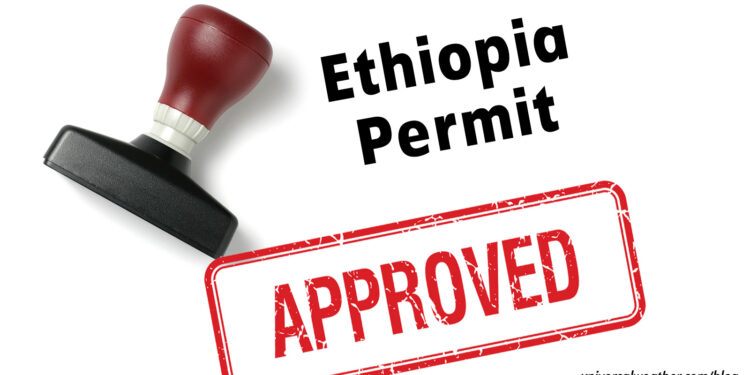Business Aircraft Ops to Ethiopia: Permits, Slots & PPRs

This is a post by author Victoria Swai. Victoria is a permits officer for Kilimanjaro Aviation Logistics Centre (KALC), a subsidiary of Universal Weather and Aviation, Inc. which is headquartered in Mwanza, Tanzania. Victoria is an expert on permits for the African region and can be contacted at victoriaswai@universalaviation.aero.
This business aviation blog post is part of a series on operating in Ethiopia and continues from our last article: “Business Aircraft Ops to Ethiopia: CIQ.“
Ethiopian landing and overflight permits are straightforward but will not be processed without full and complete information and operating schedules. When landing in Ethiopia the purpose of your flight, along with a local business contact, must always be provided to the Civil Aviation Authority (CAA).
The following is an overview of what you need to know:
1. Permit, airport slot and PPR requirements
Permits are needed for overflight of Ethiopia and well as travel to/from the country. Official permit lead time is 72 working hours. Once an overflight or landing permit has been confirmed it will have validity for +72 hours. You’ll receive a confirmation number that must be placed in remarks section 18 of your flight plan. Currently, no airports in Ethiopia require airport slots or prior permission required (PPR). However, it’s anticipated that slots may become a requirement at some point for Addis Ababa (HAAB), due to increasing traffic volume at this location.
2. Landing permits
Requirements for private non-revenue and charter (non-scheduled commercial) landing permits are similar. Lead time for permits is 72 working hours, and they’re only processed during CAA’s normal operating hours of Monday-Friday 0800-1700 local. All permit requests must provide entry/exit points and times as well as routings into/out of the country.
3. Overflight permits
All aircraft transiting Ethiopian airspace require overflight permits. While lead time for these permits is also 72 working hours, CAA processes overflight requests outside of normal office hours. Note that overflight permits are not needed for over water routes where the landmass is not overflown. Overflight permits are also not required when arriving/departing Djibouti on airway G667.
4. Permit revisions
Permit revisions are required for schedule changes (outside of validity window), tail number changes and any changes to departure/destination points. However, changes to crew and/or passenger information do not usually require permit revisions. Lead time for revisions is a minimum of 12 working hours. Once CAA receives your revision request they’ll determine if a new permit number is needed or if your original permit number will remain the same.
5. Tech stops
For tech or crew rest stops in Ethiopia landing permits are required, but no documentation needs to be submitted in advance. In these cases you just submit a landing permit request along with schedule and aircraft and operator information.
6. Non-tech stops in the country
For any landing in Ethiopia with the exception of tech or crew rest purposes, local business contact information must always be submitted in advance. In addition, the business contact must also submit a letter to CAA confirming the invitation for the passengers to come to Ethiopia. Your 3rd-party provider or ground handler can assist in coordination of business contact letters and provide suggested templates. No other documentation needs to be provided for permit purposes, but you must always carry worldwide insurance onboard when traveling to/from Ethiopia. Note that CAA needs to communicate directly with your named sponsor prior to approving a landing permit. In the case of tourism flights your ‘business contact’ can be a tour company or even your hotel. Landing permits, in most cases, can be obtained within 72 hours.
7. Short notice permits and CAA operating hours
Ethiopian CAA is normally available 24 hours a day, but normal office hours are Monday-Friday 0800-1700 local. Landing permits are only processed during normal office hours, but overflight permits and short-notice air ambulance permits can be processed outside these hours. Note that CAA is strict on permit lead times, other than for air ambulance operations where short notice requests are possible. Also, it’s important to note that if you do have an ambulance flight, you will also need to ensure that an ambulance and the doctor from the hospital the patient is leaving from or traveling to will need to be present upon the aircraft’s arrival.
8. Operating restrictions
Any flights to/from or over Eritrea will be denied Ethiopian permits. So, if you’re overflying Ethiopian airspace you’ll need to avoid Eritrea as a whole. Flights to/from Israel are also strictly prohibited. Due to border problems in the Eritrea area, CAA has issued NOTAMs temporarily withdrawing use of certain sections of airways within Ethiopian airspace to safeguard civilian aircraft operations.
9. Cabotage considerations
Note that cabotage is strictly prohibited within Ethiopia for charter operations. Charter aircraft may only operate to a single destination within the country. If you plan to travel within Ethiopia you’ll need to use a locally registered operator for any domestic additional flight sectors. While domestic legs are permitted for private flights, CAA wants to know the purpose of your flight and your reasons for traveling to each destination.
10. Permit charges and fees
Air navigation fees are charged for all transits of Ethiopian airspace. When landing in the country, these charges are included as part of the landing fee you’ll pay upon arrival. It’s recommended to have your ground handler extend credit for these charges as otherwise you’ll need to pay in cash. Overflight navigation fees are usually billed to your 3rd-party provider, and they can extend credit for this. Be aware that if any air navigation fees are outstanding to Ethiopia this may lead to permit denials.
11. Additional reading: Business Aircraft Ops to Ethiopia – Series Index
Note: Links will be updated as articles are published.
- Part 1 – Airports and services
- Part 2 – Ground handling
- Part 3 – Fuel and security
- Part 4 – Customs, immigration, and quarantine
- Part 5 – Permits
- Part 6 – Flight planning
- Part 7 – Hotels, local area and weather
Conclusion
Ethiopian CAA has a good understanding of general aviation (GA) operating requirements, but the permit process here is strict and must be followed exactly. In addition to providing sufficient lead time for permits it’s absolutely critical to supply a local business contact with all landing permit requests. Also, CAA is strict regarding cabotage for charter operators when traveling to Ethiopia.
Later we’ll discuss flight planning for Ethiopia and their impact on your trip.
Questions?




